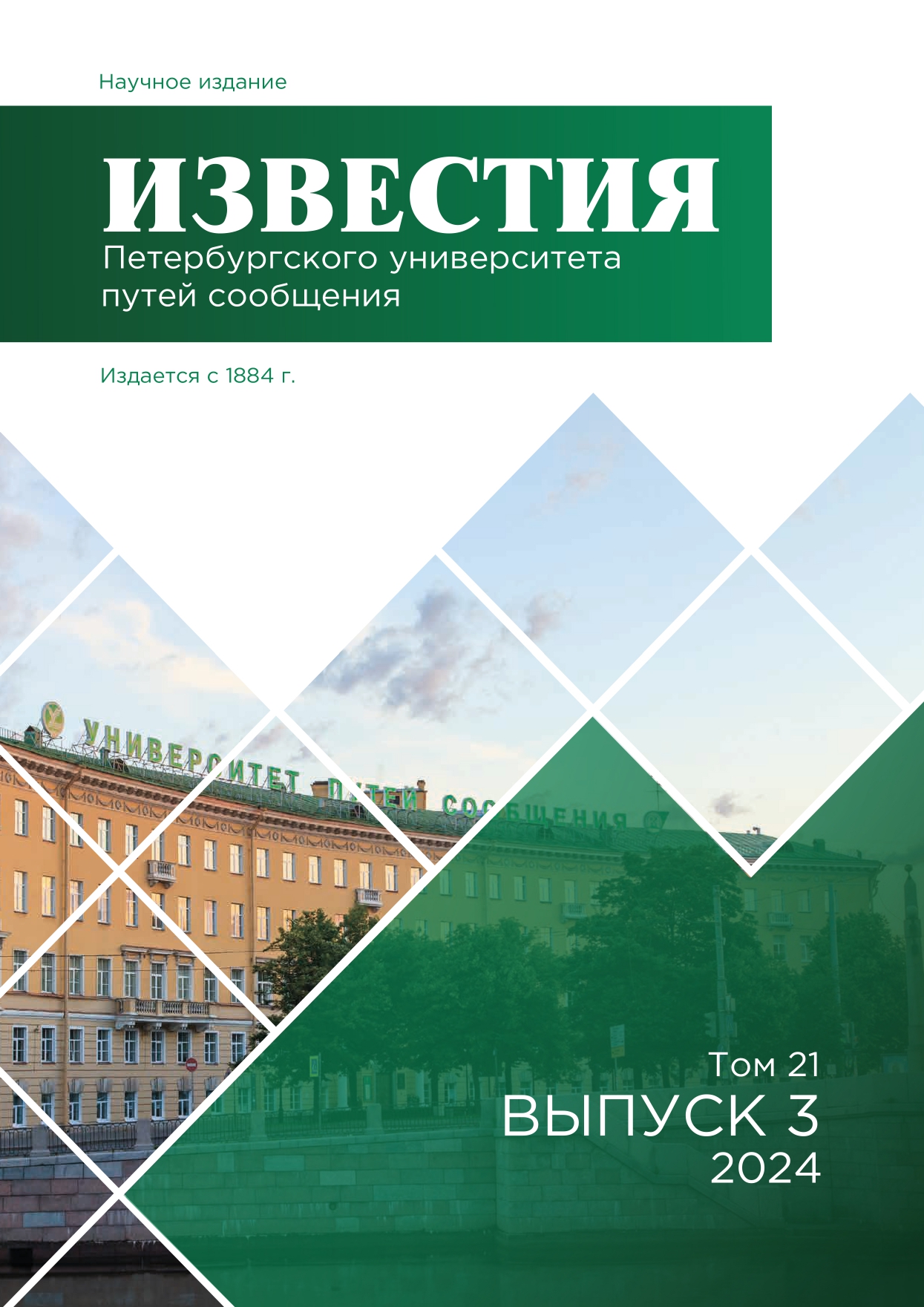Russian Federation
Russian Federation
Russian Federation
Purpose: to develop proposals for the development of the expected growth in traffic volumes along the North–South transport corridor. To assess the capacity of the Upper Baskunchak — Astrakhan — Olya port section as the most heavily loaded, where cargo flows from several directions merge. To show the need to unload the main direction of the North-South corridor and form a network of alternative routes in the transport corridor to ensure transportation guarantees in case of force majeure. Consider the possibility of attracting parallel routes through the North Caucasus Railway (SKZHD). Methods: the calculation of throughput was carried out using the methodology used in JSC “Russian Railways” and the author’s proposals, taking into account additional reserves of throughput. General logical methods were used — quantitative and qualitative analysis and synthesis, induction and deduction, analogies, classifications, a combination of historical and logical analyses. The proposed universal algorithm, which makes it possible to evaluate the possibility of choosing parallel moves, can be recommended for practical use. Results: the maximum number of trains that can be redirected to parallel routes has been established, taking into account the available capacity and their workload with export cargo traffic in the direction of the ports of the Azov-Black Sea basin. The relevance of the direction of development of heavy traffic aimed at reducing the required capacity and reducing inter-train intervals to increase the available capacity is shown. A universal algorithm has been formed that allows evaluating the possibility of choosing parallel moves. Practical significance: the necessity of mastering the expected cargo flow and preventing its departure to competing destinations, for example, through the Suez Canal, is shown. In the current political and economic conditions, the North — South International Transport Corridor (ITC) is changing its status: from an alternative to the Suez Canal, it is becoming one of the priority routes for Russian export cargo traffic.
transport corridor, cargo flow, section, capacity, event, parallel route, algorithm
1. Mathematical modelling of the railway station’s technological parameters in transport corridor system of export traffic increasing volumes / E. V. Ryazanova [et al.] // E3S Web of Conferences. 2023. Vol. 431. P. 13. DOI:https://doi.org/10.1051/e3sconf/202343108014.
2. Zhuravleva N., Gulyi I. Economic assessment of the cost of reducing the delivery time for cargo owners when sending goods through the international transport corridor “North — South” // E3S Web of Conferences. 2023. Vol. 460. P. 7. DOI:https://doi.org/10.1051/e3sconf/ 202346003014.
3. Kazanskaya L., Chetchuev M. Assessment of development prospects, economic effects and return on investment in the infrastructure of the international transport corridor “North — South” // E3S Web of Conferences. 2023. Vol. 460. P. 7. DOI:https://doi.org/10.1051/e3sconf/ 202346003015.
4. Mery po soglasovannomu razvitiyu infrastruktury na podhodah k portu Olya v usloviyah prognoziruemogo rosta gruzopotokov po transportnomu koridoru «Sever — Yug» / V. N. Zubkov [i dr.] // Vestnik Rostovskogo gosudarstvennogo universiteta putey soobscheniya. 2023. № 1. S. 63–75. DOI:https://doi.org/10.46973/0201–727X_2023_1_63.
5. Perspektivy issledovaniy transportno-tehnologicheskih parametrov uzlovyh punktov koncentracii i raspredeleniya priportovyh vagonopotokov / V. I. Zadorozhniy [i dr.] // Vestnik Rostovskogo gosudarstvennogo universiteta putey soobscheniya. 2022. № 1 (85). S. 72–81. DOI:https://doi.org/10.46973/0201–727X_2022_1_72.
6. Chislov O. N., Bezusov D. S., Zayac S. G. Variant ocenki etapnosti razvitiya priportovyh stanciy na napravleniyah yuzhnorossiyskih transportnyh koridorov // Trudy RGUPS. 2014. № 2. S. 153–163.
7. Chislov O. N., Bezusov D. S. Metody vybora i ocenki tehniko-tehnologicheskih parametrov priportovyh gruzovyh stanciy // Transport: nauka, obrazovanie, proizvodstvo: sbornik nauchnyh trudov mezhdunarodnoy nauchno-prakticheskoy konferencii «Transport‑2019». Rostov n/D.: RGUPS, 2019. T. 1: Tehnicheskie nauki. S. 76–80.
8. Chebotareva E. A. Analiz meropriyatiy po povysheniyu propusknoy sposobnosti uchastkov Severo-Kavkazskoy zheleznoy dorogi // Transport: nauka, tehnika, upravlenie. 2022. № 1. S. 29–34.
9. Mezhdunarodnyy transportnyy koridor «Sever — Yug»: sozdanie transportnogo karkasa Evrazii: doklad 21/5 / E. Vinokurov [i dr.]. Almaty; M.: Evraziyskiy bank razvitiya. 2021. S. 124.
10. Zubkov V. N., Ryazanova E. V., Nauruzbaev S. M. Sovershenstvovanie raboty stancii Astrahan'-II v sisteme mezhdunarodnogo transportnogo koridora «Sever — Yug» v usloviyah ozhidaemogo rosta gruzopotoka // Vestnik Rostovskogo gosudarstvennogo universiteta putey soobscheniya. 2022. № 4. S. 118–127. DOI:https://doi.org/10.46973/0201–727X_2022_4_118.
11. Vereskun V. D., Mamaev E. A., Sorokin D. V. Ocenka perspektiv rosta gruzooborota mezhdunarodnogo transportnogo koridora «Sever — Yug» v sovremennyh usloviyah // Vestnik Rostovskogo gosudarstvennogo universiteta putey soobscheniya. 2023. № 3. S. 45–56. DOI:https://doi.org/10.46973/0201– 727X_2023_3_45.
12. Mamaev E. A., Sorokin D. V., Dolgiy I. D. K ocenke potenciala razvitiya mezhdunarodnogo transportnogo koridora: teoreticheskie aspekty // Vestnik Rostovskogo gosudarstvennogo universiteta putey soobscheniya. 2020. № 4. S. 89–101. DOI:https://doi.org/10.46973/0201–727X_2020_4_89.
13. Mamaev E. A., Sorokin D. V. K ocenke potenciala razvitiya mezhdunarodnogo transportnogo koridora «Sever — Yug» // Izvestiya Transsiba. 2020. № 3 (43). C. 86–96.
14. Levin D. Yu. Dispetcherskie centry i tehnologiya upravleniya perevozochnym processom: uchebnoe posobie. M.: Marshrut, 2005. 760 s.
15. Voronin V. A., Vorob'ev V. V., Esyrev S. N. ALSO s podvizhnymi blok-uchastkami // Avtomatika, svyaz', informatika. 2011. № 6. S. 44–45.
16. Muginshteyn L. A., Shenfel'd K. P. Opyt vnedreniya tyazhelovesnogo dvizheniya na zheleznyh dorogah // Zheleznodorozhnyy transport. 2016. № 3. S. 35–41.
17. Dmitrenko A. V., Larchenko E. A., Eremenko A. A. Effektivnye puti povysheniya srednego vesa gruzovyh poezdov // Vestnik sibirskogo gosudarstvennogo universiteta putey soobscheniya. 2021. № 4. S. 69–74. DOI:https://doi.org/10.52170/1815– 9265_2021_59_69.









